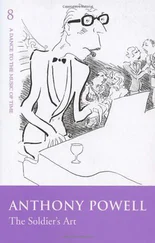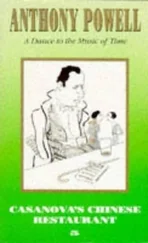Anthony Powell - Hearing Secret Harmonies
Здесь есть возможность читать онлайн «Anthony Powell - Hearing Secret Harmonies» весь текст электронной книги совершенно бесплатно (целиком полную версию без сокращений). В некоторых случаях можно слушать аудио, скачать через торрент в формате fb2 и присутствует краткое содержание. Год выпуска: 2005, Жанр: Современная проза, на английском языке. Описание произведения, (предисловие) а так же отзывы посетителей доступны на портале библиотеки ЛибКат.
- Название:Hearing Secret Harmonies
- Автор:
- Жанр:
- Год:2005
- ISBN:нет данных
- Рейтинг книги:5 / 5. Голосов: 1
-
Избранное:Добавить в избранное
- Отзывы:
-
Ваша оценка:
- 100
- 1
- 2
- 3
- 4
- 5
Hearing Secret Harmonies: краткое содержание, описание и аннотация
Предлагаем к чтению аннотацию, описание, краткое содержание или предисловие (зависит от того, что написал сам автор книги «Hearing Secret Harmonies»). Если вы не нашли необходимую информацию о книге — напишите в комментариях, мы постараемся отыскать её.
The novels follow Nicholas Jenkins, Kenneth Widmerpool and others, as they negotiate the intellectual, cultural and social hurdles that stand between them and the “Acceptance World.”
Hearing Secret Harmonies — читать онлайн бесплатно полную книгу (весь текст) целиком
Ниже представлен текст книги, разбитый по страницам. Система сохранения места последней прочитанной страницы, позволяет с удобством читать онлайн бесплатно книгу «Hearing Secret Harmonies», без необходимости каждый раз заново искать на чём Вы остановились. Поставьте закладку, и сможете в любой момент перейти на страницу, на которой закончили чтение.
Интервал:
Закладка:
Although a card had arrived for a Private View at this gallery, a new one, these two exhibitions had run for at least a fortnight before I found opportunity to pay a visit. Returning to the newspaper article — having been to the gallery — I felt less surprise at the critic’s warm responses, not only to the Deacons, but also to the Victorian seascapes. That was probably due, as much as anything else, to a desire to keep in the swim. There was also a sense of satisfaction in reading praise of Mr Deacon (to me he always remained ‘Mr Deacon’), given by a responsible art critic; a young one at that. The last quality would have delighted Mr Deacon himself. He had once remarked that youth was the only valid criterion in any field. He himself never quite achieved a fusion of the physical and intellectual in propagating that view. Certainly the notice marked how far tastes had altered since the period — just after the second war — when I had watched four Deacons knocked down for a few pounds in a shabby saleroom between Euston Road and Camden Town. At the time, I had supposed those to be the last Deacons I should ever set eyes on. In a sense they were; the last of the old dispensation. The pictures on view at the Barnabas Henderson Gallery (the show specifically advertised as the Bosworth Deacon Centenary Exhibition) were not so much a Resurrection as a Second Coming.
If the rehabilitation of Mr Deacon’s art had not in itself provided an overriding inducement to visit the exhibition, the name of the gallery — proving all curiosity was not at an end — would have gone a long way as an alternative inducement to do so. A single-page pamphlet, accompanying the Private View card, outlined the aims of this new picture firm, which had just come into being. They seemed admirable ones. The premises were in the neighbourhood of Berkeley Square. It was rather late in the afternoon when I finally reached the place, a newly painted exterior, the street in process of being rebuilt, the road up, several Georgian houses opposite looking as if they had been recently bombed. In the window of the Barnabas Henderson Gallery itself a poster proclaimed Mr Deacon’s name in typography of a size, and fount, he would have approved, an aureole of favourable press notices pinned round about.
Within, I found myself surrounded by Deacon canvases assembled on an unprecedented scale; more Deacons than might be supposed even to have been painted, far less survived. The Victorian seascapes were segregated in a room beyond, but an arrow pointed to an extension of the Deacon Centenary Exhibition on the upper floor, which I decided to explore first. The red tag of a sale marked a high proportion of the pictures. Two of those so summarily dismissed at the down-at-heel auction-rooms were immediately recognizable from their black-and-gold Art Nouveau frames, Deacon-designed to form part of the picture itself; a technique Mr Deacon rather precariously supported by quoting two lines from Pericles :
In framing an artist, art hath thus decreed:
To make some good, but others to exceed.
In the shabby saleroom this purpose of the frames had been obscured by dirt and tarnished paint, which cleaning and restoration now made clear. Light in pigment, some of the canvases were huge in size, remembered subjects included Hellenic athletes painfully straining in some contest; another (too grimy at the time to be properly appreciated), a boy slave reproved by his toga-enveloped master, whose dignified figure was not without all resemblance to Mr Deacon himself in his palmy days. The show was stylish in presentation. In fact Barnabas Henderson had done a stupendous rescue job from the Valley of Lost Things; Mr Deacon’s Astolpho, or perhaps one of the well disposed swans, fishing up his medallion for the Temple of Fame. Henderson clearly knew his business. To have supposed him the dim figure he had seemed, only a few months earlier in the same year, under the Murtlock regime, was an error of judgment. Since his self-manumission at Stourwater the Private View card was the first I had heard of him; nor was there any further news of Murtlock and Widmerpool.
Even Mr Deacon’s closest friends were accustomed to smile tolerantly, behind his back, about his painting. The few patrons had all faded away by the later stages of his life, when he had exchanged an artist’s career for an antique-dealer’s. All the same, in days when Barnby’s studio was above the antique shop, Barnby had remarked that, little as he approved himself, Sickert had once put in a good word for Mr Deacon’s work. Looking round, more impressed than I should have been prepared to admit, I took heart from Sickert’s judgment; at the same time trying to restore self-confidence as to an earlier scepticism by noting something undoubtedly less than satisfactory in the foreshortening of the slave boy’s loins.
There was still no one about in the first ground floor room of the gallery when I returned there, the attendant’s desk in the corner unoccupied. Through a door at the far end several persons, one of them in a wheel-chair, were to be seen perambulating among the Victorian seascapes. I had not at first noticed that one of the smaller pictures in this first room was Boyhood of Cyrus . Moving across to ascertain how closely, if at all, the palace in its background resembled the configurations of the local quarry, I was intercepted by Barnabas Henderson himself, who came hurrying up a flight of stairs leading from the basement. It was instantaneously apparent that he was a new man; no less renovated than the Deacon pictures on the walls. That was clear in a flash, a transformation not in the least due to adjustments in dress and personal appearance, also to be observed. He had slightly shortened his haircut, reverted to a suit, elegant in cut without being humdrum in style, wore a tie of similar mood. These, however different from a blue robe, were trivial modifications in relation to the general air of rebirth. There was a newly acquired briskness, even firmness of manner, sense of self-confidence amply restored.
‘Oh, hullo, Nicholas. You received our card all right? I was afraid it might have gone astray, as you hadn’t been in.’
‘I couldn’t get to the Private View.’
‘I hope your wife will look in, too, before the Deacon show closes. I always remember how good she was about our turning up once with that awful man. I was quite ashamed at the time. We went crayfishing, do you remember? It was an unusual experience. I can’t say I enjoyed it much. Still, I didn’t enjoy anything much in the circumstances of what my life was then. I hope you like these pictures — and the ones in the next room too, which are by various painters. Bosworth Deacon is one of my own discoveries.’
‘I used to know him.’
‘Know whom?’
‘Edgar Deacon.’
‘Who was Edgar Deacon — a relation of Bosworth Deacon?’
‘He was called Edgar. Bosworth was only his middle name.’
‘No, no. Bosworth is the painter’s name. Are you sure you aren’t confusing your other Deacon man? Bosworth Deacon is a most remarkable artist. In his way unique. I can think of no other painter like him.’
Henderson, possibly with reason, was not in the least interested in whether or not I had known Mr Deacon. Perhaps it was not really a relevant subject; or rather seemed relevant only to myself. It was clear that Mr Deacon — born a hundred years before — seemed in Henderson’s eyes a personage scarcely less remote in time than the kindly slave-master of the artist’s own self-image.
‘I saw you were making for Boyhood of Cyrus , one of Deacon’s best. On the whole I prefer the smaller compositions. He’s more at ease with figure relationships. Several of the critics picked out Cyrus in their notices. I sold it within an hour of the show opening.’
Читать дальшеИнтервал:
Закладка:
Похожие книги на «Hearing Secret Harmonies»
Представляем Вашему вниманию похожие книги на «Hearing Secret Harmonies» списком для выбора. Мы отобрали схожую по названию и смыслу литературу в надежде предоставить читателям больше вариантов отыскать новые, интересные, ещё непрочитанные произведения.
Обсуждение, отзывы о книге «Hearing Secret Harmonies» и просто собственные мнения читателей. Оставьте ваши комментарии, напишите, что Вы думаете о произведении, его смысле или главных героях. Укажите что конкретно понравилось, а что нет, и почему Вы так считаете.



